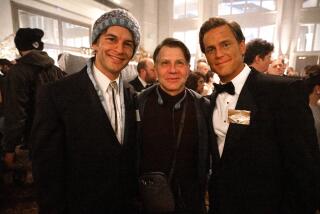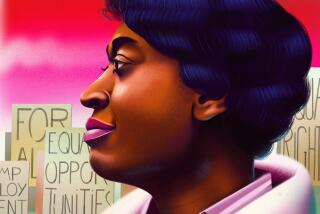Harry Hay, 90; Gay Liberation Pioneer, Communist
Harry Hay, who died Thursday of lung cancer at 90, earned an unusual distinction as a founder of the gay liberation movement and a member of the Communist Party, which banned homosexuals.
From the 1950s on, in frequent lectures and essays, Hay chronicled his transition from a married man with two children in the 1940s to a gay activist who founded the Mattachine Society, a national support group for gays, in the early 1950s. After he was expelled from the Mattachines several years later for his extreme politics, he went on to help launch the Radical Faeries, a gay spirituality movement that started in 1979.
For these bold steps, Hay is credited with making Los Angeles the first home to one of the most controversial social movements of the last century. “Hay is right up there with a handful who made the gay movement possible,” said Professor Martin Duberman, who founded the Center for Gay and Lesbian Studies at the City University of New York’s school of graduate studies. “He was the pioneer for gay men’s rights.”
Hay spent most of his life advocating a coalition of all minorities and arguing that each group’s cause was part of a larger progressive movement. In the 1970s he supported equal rights for women, as well as Native American issues. In the ‘80s he helped to found the gay caucus of Jesse Jackson’s Rainbow Coalition.
His dual identity as a Communist and a gay activist set Hay apart among leaders of the gay movement. His separate-but-equal stance forced an early debate within the movement that still continues. Should gays and lesbians assimilate into mainstream society, or not? Hay was against it and emphasized his position by his gender-bender style of dress. He wore the knit cap of a macho longshoreman, a pigtail and a strand of pearls.
“Assimilation absolutely never worked at all,” he declared in an interview with the Progressive, a magazine about social causes, in 1998. “You may not think you are noticeable but ... you are.” He favored openness and used the words of William Shakespeare to support his point of view, quoting the familiar line from “Hamlet”: “This above all, to thine own self be true.”
Hay was born in Worthing, England, the son of a mining engineer. From the age of 11, he knew that he was attracted to boys, not girls. In those years, he later explained, the term “homosexual” was not included in most dictionaries. “We had no words to describe ourselves,” he said. He referred to homosexuals as, “temperamental guys.”
Hay’s father moved the family to Los Angeles in 1919 and Hay entered Stanford University in 1930, but soon dropped out and returned to Los Angeles to pursue his interest in acting. He met Will Geer, an actor and political leftist best remembered as Grandpa on the 1970s television series “The Waltons.”
Geer introduced Hay to the city’s Communist Party, and by 1935 both men were members. Soon after, Hay stumbled on his life’s work when he joined a maritime strike in San Francisco that turned violent. The National Guard was called in, two people were killed, many others were injured, and Hay’s twin passion for political activism and community organizing was ignited.
In those years he supported himself by teaching part time at the People’s Educational Center, a Marxist-oriented school in downtown Los Angeles, acting, and doing odd jobs. “Harry was always led by the seat of his pants to make ends meet,” says Hay’s biographer, Stuart Timmons. “Activism was his primary calling.”
His attraction to communism took root in the party’s claim of solidarity with all underprivileged people. Hay included homosexuals in that group, and referred to them as an “oppressed minority.” That vision soured as the party grew virulently anti-homosexual by the mid-1940s.
When he was 25 years old, alone and lonely, Hay met with a psychiatrist. “I had been looking for another guy who would share my political feelings and my passion to organize,” he later explained in an interview. His doctor suggested that he have a heterosexual relationship, saying it might change his sexual preference from men to women.
The following year he married Anita Platky, an activist in the party. They stayed together for 13 years and adopted two daughters, Hannah and Kate. But marriage didn’t change him. “I knew I was gay in every bone of my body,” he later said. The couple divorced in 1951, on the grounds of extreme cruelty. His family was deeply wounded by Hay’s politics and his ongoing gay affairs. One daughter never spoke to him again; the other remained cordial but distant.
Also in 1951, Hay resigned from the Communist Party. By then, Russia’s strongman Josef Stalin was shipping homosexuals to Siberia as social deviants. In the U.S. two years later, President Eisenhower barred homosexuals from all federal employment including the military. “Homosexuality became equated with being a traitor,” Duberman said. “The thinking was that if you were gay and you did any type of government work, you were susceptible to blackmail by communist agents.”
Hay met Rudi Gernreich, a fledgling fashion designer, in 1950 at a dance studio in Los Angeles. Gernreich was destined for fame as the inventor of the topless bathing suit for women in the mid-1960s. The two men shared political ideals, and Gernreich encouraged Hay to start the Mattachine Society, which he had first envisioned in the late 1940s. Hay chose the name from a secret all-male society of 15th century Europe and structured it after the Communist Party’s cells.
When the Mattachines met for discussions, members brought a “cover” girl, a female friend or relative. It was against the law in California for gay men to meet in groups.
“The possibility of a police raid ... required that their meetings be held in secret,” Timmons wrote in the biography “The Trouble With Harry Hay” (Alyson Publications, 1990). When someone new was invited, Timmons wrote, “it was standard procedure for him to meet a Mattachine member in public, then be driven around for a few blocks before being taken to the meeting place.”
Timmons compares the Mattachines to an early gay consciousness raising group. “For homosexuals to meet and share with each other in a nonsexual environment was rare,” he wrote.
In 1952, the group caught public attention when one of its members was arrested in an entrapment case and charged with lewd conduct. The trial ended in a hung jury; charges were dismissed. Hay later said the case attracted several thousand new members from across the country.
Within months of that trial, Hay was forced out of the society he had founded. An increasingly conservative majority of its leaders considered him a liability. “Homosexuals did not want leadership that represented communist ideas,” said Walter L. Williams, a professor of anthropology and gender studies at USC. “Harry withdrew, embittered.”
Not without a few choice words. “Harry could be fiery, prickly at times; he had a temper” said Timmons, who met Hay when he spoke at UCLA in the mid-1970s. “He could make people very upset.”
In 1955, Hay was called before the House Un-American Activities Committee, and although he was not charged with any crime, he dropped out of the limelight after that. In 1963, at age 51, he met John Burnside, the inventor of the teleidoscope, a variation on the kaleidoscope, who became his life partner. They moved to New Mexico in 1970 and managed a trading post on a Pueblo Indian reservation north of Santa Fe.
Back in Los Angeles in the ‘80s after a fire destroyed Burnsides’ teleidoscope factory, they shared a book-laden house on Melrose Avenue in Hollywood. By 1999, Hay was ailing, but he accepted an invitation to be the grand marshal of the annual gay pride parade in San Francisco. The gay community took him in and he never returned to Los Angeles. He spent his last years in a Victorian house, painted pink.
Besides his two adopted daughters, Hay is survived by his partner, Burnside.
Donations in his name may be made to the Southern California Library for Social Studies and Research, 6120 S. Vermont Ave., Los Angeles, CA 90004.
More to Read
The biggest entertainment stories
Get our big stories about Hollywood, film, television, music, arts, culture and more right in your inbox as soon as they publish.
You may occasionally receive promotional content from the Los Angeles Times.










